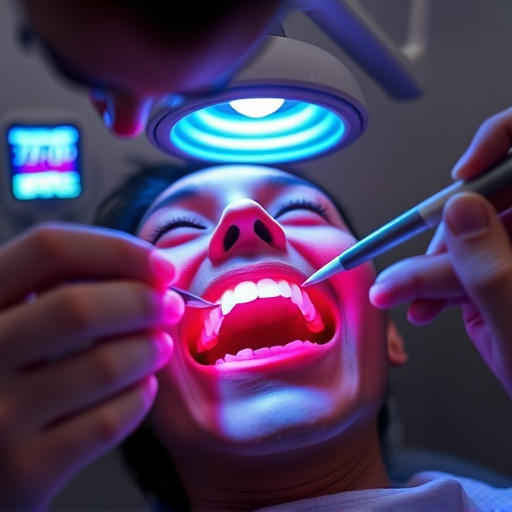Experience Painless Root Canal Treatment: A Step-by-Step Guide

Root canal treatment saves damaged teeth by removing infected pulp, cleaning canals, and filling the…….
Welcome to an in-depth exploration of root canal treatment—a critical dental procedure that has transformed oral healthcare globally. This article aims to guide you through the intricate world of endodontics, offering a comprehensive understanding of its history, techniques, impact, and future directions. By delving into these aspects, we will uncover why root canal treatment is not just a routine procedure but a significant intervention with far-reaching implications.
Definition: Root canal treatment (RCT), also known as endodontic therapy, is a dental procedure aimed at salvaging a badly damaged or infected tooth. It involves accessing the tooth’s root canal system, cleaning and shaping it, and then filling and sealing it to prevent further infection.
Components: The process comprises several key steps:
Diagnosis: A thorough examination by a dentist or endodontist determines the need for RCT. This includes X-rays, visual inspection, and testing for tooth sensitivity and pulse.
Access Opening: Using local anesthesia, the dentist creates a tiny opening in the affected tooth to gain access to the root canal.
Cleaning and Shaping: Special files are used to remove infected or damaged tissue (pulp) from the root canal. This meticulous process ensures all traces of infection are eliminated.
Filling and Sealing: After cleaning, a rubber-like material called gutta-percha is placed in the canal to fill it. This material and an adhesive ensure the canal remains sealed, preventing reinfection.
Crown Placement (Optional): In many cases, a custom-made crown is fitted over the treated tooth to restore its strength and appearance.
Historical Context: The concept of RCT dates back centuries. Ancient civilizations like the Greeks and Egyptians practiced primitive forms of root amputation for tooth extraction. However, modern endodontics emerged in the 19th century with improvements in microscopy and dental tools. Dr. John M. Thompson is often credited with advancing the field, publishing groundbreaking works on endodontic techniques in the early 20th century.
International Influence: Root canal treatment has left an indelible mark on global oral health. The World Health Organization (WHO) recognizes its importance in achieving universal health coverage. According to a study by the International Association of Dental Research (IADR), RCT is one of the most commonly performed dental procedures worldwide, with over 57 million treatments estimated in 2017.
Regional Disparities: Despite its widespread availability, access to RCT varies significantly across regions. High-income countries generally have higher rates of endodontic treatment, while low- and middle-income nations face challenges due to limited resources and dental infrastructure. For instance, a 2020 report by the Global Oral Health Federation (GOHF) revealed that only 37% of children in sub-Saharan Africa received appropriate dental care, including RCT when needed.
Trends Shaping RCT: Several trends are influencing the global trajectory of root canal treatment:
| Trend | Impact |
|---|---|
| Digitalization: Advanced technologies like 3D imaging and electronic apex locators enhance precision during RCT, improving outcomes. | Increased accuracy, reduced treatment time, better patient satisfaction. |
| Minimally Invasive Techniques: These focus on preserving tooth structure, reducing complications, and providing more comfortable experiences for patients. | Higher patient acceptance, decreased post-operative pain, lower risk of infection. |
| Global Dental Tourism: Some countries attract patients seeking affordable RCT, contributing to cross-border healthcare exchange. | Benefits access to advanced techniques but raises concerns about quality control and regulation. |
Market Dynamics: The global endodontics market is a significant segment within the dental industry. According to ResearchAndMarkets.com, this market was valued at USD 6.5 billion in 2021 and is projected to grow at a CAGR of 4.8% from 2022 to 2030. Key factors driving this growth include rising dental awareness, aging populations, and technological advancements.
Investment Patterns: The economic viability of RCT attracts investments from various sources:
Private Dental Practices: Many dentists invest in endodontic equipment and training to offer advanced treatment options, enhancing their services and attracting more patients.
Hospitals and Clinics: Public healthcare facilities allocate resources for endodontic services, ensuring accessible oral care for the population.
Medical Tourism: Countries promoting dental tourism incentivize investment in RCT infrastructure to attract international patients.
Economic Impact: Root canal treatment has far-reaching economic implications:
Cost-Effectiveness: RCT is cost-effective compared to alternatives like tooth extraction and replacement with bridges or implants, making it a preferred option for many patients and healthcare systems.
Reduced Absenteeism: By preventing tooth pain and infection, RCT can decrease workplace absenteeism and associated productivity losses, contributing to economic efficiency.
Public Health Benefits: Improving oral health through accessible RCT contributes to overall public health, reducing the burden of dental diseases on healthcare systems.
Innovation in Tools and Materials: Technological breakthroughs have significantly enhanced the effectiveness and efficiency of root canal treatment:
Nickel-Titanium (NiTi) Files: These flexible files allow for easier navigation within complex canal anatomies, improving cleaning and shaping accuracy.
Electronic Apex Locators: Digital devices help determine the canal’s endpoint, reducing over-instrumentation and ensuring proper filling of the entire canal.
3D Imaging and Modeling: Advanced imaging techniques enable precise planning and visualization of the root canal system, aiding in treatment success.
Remote Monitoring and Teledentistry: Modern communication technologies allow dentists to remotely monitor patients undergoing RCT, providing real-time feedback and support. This is particularly beneficial for underserved communities with limited access to dental care.
Future Potential: The future holds even greater possibilities:
Artificial Intelligence (AI): AI algorithms can assist in diagnosing root canal pathologies, planning treatments, and even performing minimally invasive procedures, potentially reducing human error.
Biomaterials: Advancements in biomaterials offer improved sealing and biocompatibility, enhancing long-term treatment outcomes.
Laser Technology: Laser applications in endodontics show promise for faster and more precise cleaning and shaping of root canals.
Global Guidelines and Standards: Various international organizations set guidelines and standards for RCT to ensure quality and safety:
World Dental Federation (FDI): FDI publishes evidence-based clinical guidelines for endodontic practices, promoting best practices worldwide.
American Association of Endodontists (AAE) and European Society of Endodontology (ESE): These organizations provide regional standards and educational resources to maintain high standards in RCT.
Regulatory Considerations: National dental boards and regulatory bodies play a crucial role in overseeing endodontic practices:
Licensing and Certification: Dentists performing RCT must obtain the necessary licenses and certifications, ensuring they meet specific competency requirements.
Quality Assurance Programs: Many countries have implemented quality assurance programs to monitor and improve the quality of dental care, including endodontic services.
Legal Aspects: Legal frameworks governing RCT address patient safety, consent, malpractice insurance, and professional liability:
Informed Consent: Patients must be fully informed about the risks, benefits, and alternatives before undergoing RCT, ensuring they make voluntary decisions.
Malpractice Claims: While rare, malpractice lawsuits related to RCT exist, emphasizing the need for strict adherence to evidence-based practices and documentation.
Main Challenges: Despite its successes, root canal treatment faces several challenges:
Complexity: The intricate anatomy of root canals and variability in patient responses make RCT a complex procedure, requiring skilled practitioners.
Infection Risk: Despite advancements, there is still a risk of infection recurrence, particularly in cases with poor patient compliance or complex anatomies.
Patient Acceptance: Some patients fear or avoid RCT due to misconceptions about pain and potential complications, hindering access to necessary care.
Criticisms and Actionable Solutions: Critics often raise concerns about the cost, time, and potential long-term effects of RCT. To address these:
Education and Awareness: Public awareness campaigns can dispel myths about RCT, emphasizing its benefits and addressing common fears.
Continuous Training: Dentists should engage in ongoing education to stay updated with the latest techniques and evidence-based practices, ensuring better treatment outcomes.
Collaborative Care Models: Integrating endodontists into dental teams and implementing collaborative care models can improve access and treatment success rates.
Case Study 1: Saving a Historic Monument’s Smile
A renowned museum in Europe faced a unique challenge—preserving the smile of a historical figure whose skeleton was on display. The exhibit required the teeth to remain intact and healthy. Through careful planning and using advanced NiTi files, an endodontist successfully performed RCT on all teeth, ensuring their longevity and visual appeal for future generations.
Case Study 2: Enhancing Quality of Life through RCT
Ms. X, a 50-year-old woman, had been experiencing severe tooth pain for months. An x-ray revealed an abscessed root canal. After explaining the procedure and addressing her concerns, the dentist performed RCT. Within weeks, Ms. X’s pain subsided, and she could enjoy meals without discomfort, significantly improving her quality of life.
Case Study 3: Overcoming Challenges in Remote Areas
A community health center in a remote village faced challenges providing endodontic care due to limited resources and trained personnel. They partnered with a dental charity to bring an endodontist for a one-week clinic. During this period, they treated over 50 patients, many of whom had never received RCT before. This initiative improved oral health and raised awareness about the importance of such services in underserved areas.
Emerging Trends: The future of root canal treatment holds exciting possibilities:
Personalized Medicine: Advancements in genomics and biomaterials may lead to personalized RCT plans, tailored to individual patient needs and anatomies.
Minimally Invasive Approaches: Ongoing research explores new techniques to further minimize the impact on tooth structure while maintaining excellent outcomes.
Digital Imaging and Modeling: Integrating AI with 3D imaging can revolutionize diagnosis and treatment planning, making RCT more precise and accessible.
Strategic Considerations: To capitalize on these trends and ensure the continued success of RCT:
Research and Innovation: Continued investment in research is vital to developing new technologies, materials, and techniques that enhance treatment outcomes and accessibility.
Global Collaboration: Sharing knowledge and resources across borders can improve endodontic practices worldwide, especially in regions with limited access to advanced care.
Policy Support: Governments and dental associations should collaborate on policies that encourage access to RCT, ensure quality care, and promote continuous professional development among endodontists.
Root canal treatment is a testament to human ingenuity and our relentless pursuit of better healthcare solutions. From its historical roots to modern technological advancements, RCT has evolved into a highly refined procedure that plays a pivotal role in oral health globally. By addressing challenges, embracing innovations, and fostering collaborations, we can ensure that root canal treatment continues to be a powerful tool in the dental arsenal, improving lives one smile at a time.
Q: Is root canal treatment painful?
A: With modern anesthesia, RCT is typically pain-free during the procedure. Mild discomfort or sensitivity after treatment is common but can be managed with over-the-counter pain relievers.
Q: How long does root canal treatment take?
A: The duration varies depending on the complexity of the case. Simple RCTs may take 30-60 minutes, while more complex cases could require several visits spanning a few weeks.
Q: Can all teeth be saved through root canal treatment?
A: While RCT is highly successful, not all teeth can be saved. Severe tooth decay or damage, complex anatomies, or patient non-compliance may make extraction the better option.
Q: Are there any long-term effects of root canal treatment?
A: When performed correctly and with proper aftercare, RCT has minimal long-term effects. However, regular dental check-ups are essential to monitor the treated tooth’s health.
Q: Is dental tourism a reliable option for root canal treatment?
A: While dental tourism can offer affordable RCT, it’s crucial to choose reputable clinics and ensure qualified practitioners. Quality control and regulatory standards vary across countries, so thorough research is essential.

Root canal treatment saves damaged teeth by removing infected pulp, cleaning canals, and filling the…….

Root canal treatment saves teeth by removing infected pulp, filling the space with biocompatible mat…….

After successful root canal treatment, proper post-care is crucial for recovery and preventing compl…….

Root canal treatment salvages severely damaged or infected teeth by cleaning and sealing the pulp ch…….

Root canal treatment saves damaged or infected teeth by removing pulp, cleaning and sealing root can…….

Root canal treatment (RCT) saves damaged teeth by addressing infected pulp, preserving tooth integri…….

Root canal treatment, performed by endodontists, saves damaged or infected teeth by cleaning and sea…….

Root canal treatment, recommended by family dentistry pros, saves damaged or infected teeth. It remo…….

Root canal treatment is a modern, comfortable procedure saving natural teeth by removing infected pu…….